-
The History of Fujiwara-no-Kiyohira and Industry
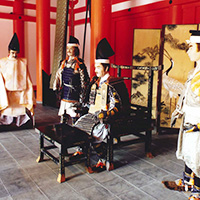
Esashi-Fujiwara Heritage Park
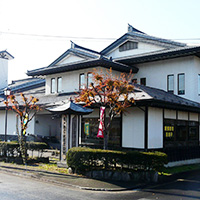
Oshu Traditional Industry Hall
Journey through the history of industry promulgated by Fujiwara-no-Kiyohara, the first of the Oshu-Fujiwara Clan, by taking a tour of the areas associated with him.
Estimated time required: 6 hours 44 minutes
 Mizusawa Interchange (IC)
Mizusawa Interchange (IC) Esashi-Fujiwara Heritage Park
Esashi-Fujiwara Heritage Park- This magnificent theme park recreates the splendor of Heian period architecture that prospered during the four generations of the Fujiwara clan.
You can enjoy learning the legends and folktales of Esashi, as well as its history, by donning the armor of warriors, trying your hand at archery and putting on kimono of the period.
 Kura-machi Mall
Kura-machi Mall- Located near Heritage Park Fujiwara-no-Sato, this street (reserved for pedestrians) maintains the atmosphere of Kura-machi. The Kurokabe Glass Gallery features displays of glassware from both domestic and foreign sources. The gallery also offers tours and workshops.
 Oshu Traditional Industry Hall
Oshu Traditional Industry Hall- Information and displays related to NANBU Ironware, such as a reproduction of a factory from the Meiji era and an activity corner for cast ironware, can be found in this hall. It is adjacent to a store with direct sales of NANBU Ironware.
 Chuson-ji Temple
Chuson-ji Temple- This foundation of this temple of the Tendai sect was laid by Jikaku Daishi Ennin in 850. It houses some of the greatest treasures of peace and art in East Japan, including the KONJIKI-DO (Golden Hall), as well as a sutra library, images of Buddha, and many national treasures and important cultural properties.
 Motsu-ji Temple
Motsu-ji Temple- Motohira Fujiwara created this Jodo garden, the oldest in Japan. It has received a double designation as a National Special Historic Site and Special Place of Scenic Beauty from the nation. A “Gokusui-no-En” (a tanka party held beside a meandering brook) is held each May, and poets adorned in the attire of nobility from the Heian period compose waka poems.
 Hiraizumi-Maesawa Interchange (IC)
Hiraizumi-Maesawa Interchange (IC)
-
The Oshu / Hiraizumi Sightseeing Bonanza!
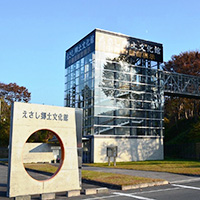
Esashi Native District Cultural Museum
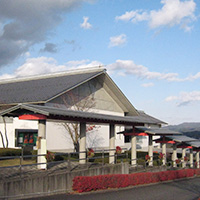
Cattle Museum
On day 1, experience the history of the Heian and Edo eras in samurai houses and where TV sagas have been shot, as well as visit facilities about space. You can stay at "HIMEKAYU," a hot spring inn rich in nature, right here in Oshu.
On day 2, after visiting "Isawa Dam," Japan's largest rock-fill dam, and Lake Oshu, you can go to Japan's only "Cattle Museum" and Chuson-ji Temple, the KONJIKI-DO (Golden Hall) and Motsu-ji Temple, all World Heritage sites.
Estimated time required: 10 hours 14 minutes
 Mizusawa Interchange (IC)
Mizusawa Interchange (IC) Esashi-Fujiwara Heritage Park
Esashi-Fujiwara Heritage Park- This magnificent theme park recreates the splendor of Heian period architecture that prospered during the four generations of the Fujiwara clan. The park has been used as locations for filming TV and movies, and sometimes filming is open to the public. You can enjoy learning the legends and folktales of Esashi, as well as its history, by donning the armor of warriors, trying your hand at archery and putting on kimono of the period.
 Esashi Native District Cultural Museum
Esashi Native District Cultural Museum- The museum is composed of three main parts, the “OKU-NO-IN” and “Hall of Agriculture” where you can see nationally designated important cultural properties such as a wooden statue of Bishamonten (a reproduction) and more than a 100 KANNON (statues of the Goddess of Mercy), as well as an “Activity Corner” where you can make SOBA noodles, weave or make ceramics.
 Oshu Space and Astronomy Museum
Oshu Space and Astronomy Museum- The museum is housed in what was the main building of the old latitude observatory built in 1967, and provides a quiet atmosphere of active preservation. It houses displays of historic astronomical devices and the structure of the universe. There is also a 4-D theater where you can enjoy three-dimensional films. Various events and seminars are held throughout the year.
 Oshu Samurai Family House Museum
Oshu Samurai Family House Museum- Under the theme of “Sightseeing in the Castle Town of Mizusawa,” many items are on display here, including a map that shows both the castle town of Mizusawa from the Edo period to modern day at a single glance, along with arms, weapons, a lattice, and an abacus.
 Yakeishi KUA-PARK Himekayu
Yakeishi KUA-PARK Himekayu- Beginning with the “BIHADA-NO-YU” (Waters of Skin Beauty) where you can bask in the hot spring while taking in the scenery of the Yakeishi Mountains, there are Eight types of baths in which you can enjoy outdoor hot springs and even wear a swim suit in some. The warm water pool is especially popular with everyone, young and old. You will also find an herb garden and bungalows on the grounds so that you can enjoy the outdoor life.
 Isawa Marugoto Information Center
Isawa Marugoto Information Center- Get the latest information on the Yakeishi Mountains, as well as many other sightseeing spots and facilities such as a landscape of scattered houses complete with traditional style fences. There is a cafe and small farmers' market in the same location, perfect for taking a break and getting information during your drive.
 Cattle Museum
Cattle Museum- This is Japan's only museum dedicated to cattle. The museum does research and has displays on Maesawa Beef and other cattle from around the world, and houses stuffed animals, frames, fossils and more to introduce the relationship between cattle and mankind, and, of course, beef cuisine. Groups who make prior reservations can learn how to make butter or do some cheese tasting.
 Chuson-ji Temple
Chuson-ji Temple- This foundation of this temple of the Tendai sect was laid by Jikaku Daishi Ennin in 850. It houses some of the greatest treasures of peace and art in East Japan, including the KONJIKI-DO (Golden Hall), as well as a sutra library, images of Buddha, and many national treasures and important cultural properties.
 Motsu-ji Temple
Motsu-ji Temple- Motohira Fujiwara created this Jodo garden, the oldest in Japan. It has received a double designation as a National Special Historic Site and Special Place of Scenic Beauty from the nation. A “Gokusui-no-En” (a tanka party held beside a meandering brook) is held each May, and poets adorned in the attire of nobility from the Heian period compose waka poems.
 Hiraizumi-Maesawa Interchange (IC)
Hiraizumi-Maesawa Interchange (IC)
-
Recollections of World Heritage Site Hiraizumi and the Great Ones of Oshu
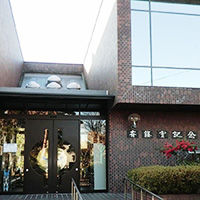
Saito Makoto Memorial Hall
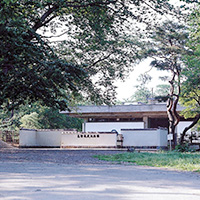
Takano Choei Memorial Hall
This course will give you a taste of those who have done great things for us, including Kiyohira Fujiwara who constructed the World Heritage Site Hiraizumi, and Goto Shinpei, who put together a plan for recovery after the Great Kanto Earthquake as President of the Imperial Capital Reconstruction Department. Others are also featured whose achievements must not be forgotten.
Estimated time required: 5 hours 44 minutes
 Hiraizumi-Maesawa Interchange (IC)
Hiraizumi-Maesawa Interchange (IC) Chuson-ji Temple
Chuson-ji Temple- This foundation of this temple of the Tendai sect was laid by Jikaku Daishi Ennin in 850. It houses some of the greatest treasures of peace and art in East Japan, including the KONJIKI-DO (Golden Hall), as well as a sutra library, images of Buddha, and many national treasures and important cultural properties.
 Goto Shinpei Memorial Hall
Goto Shinpei Memorial Hall- Born in Kichikoji, Mizusawa, Oshu, Goto Shinpei had many great achievements. Many items are on display, including a collection of his works in the “Goto Shinpei Documents,” photographs and translations.
 Oshu Samurai Family House Museum
Oshu Samurai Family House Museum- Under the theme of “Sightseeing in the Castle Town of Mizusawa,” many items are on display here, including a map that shows both the castle town of Mizusawa from the Edo period to modern day at a single glance, along with arms, weapons, a lattice, and an abacus.
 Saito Makoto Memorial Hall
Saito Makoto Memorial Hall- Saito Makoto held such important positions as Minister of the Navy, Governor-General of Korea and Prime Minister. On display are some of the items he used in his daily life, letters, awards and mementos from the February 26 Incident in which he was assassinated.
 Takano Choei Memorial Hall
Takano Choei Memorial Hall- This Memorial Hall will introduce you to the history and great achievements of Takano Choei, a person of Dutch learning from the late Tokugawa period. On display are more than 200 items, including his diary written while in prison, translations and mementos. Fifty-eight of these items are Nationally Designated Important Cultural Properties.
 Mizusawa Sightseeing and Products Center, Z-Plaza Aterui
Mizusawa Sightseeing and Products Center, Z-Plaza Aterui- The center offers sightseeing information for all of Iwate Prefecture, with an emphasis on Oshu, as well as sells various special products and fresh agricultural products. There is a cafe and a snack booth as well. It is fully equipped with a large parking lot and public restrooms.
 Mizusawa Interchange (IC)
Mizusawa Interchange (IC)
-
A Pilgrimage to Ancient Temples in the World Heritage site of Hiraizumi and Oshu
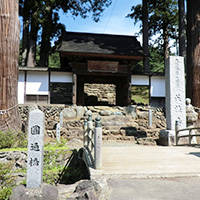
Shobo-ji Temple
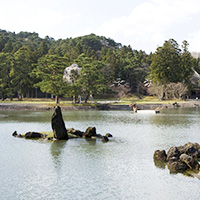
Motsu-ji Temple
This course will take you on a pilgrimage to ancient temples in Hiraizumi, registered as a World Heritage Site, and neighboring Oshu.
Estimated time required: 6 hours 58 minutes
 Mizusawa Interchange (IC)
Mizusawa Interchange (IC) Shobo-ji Temple
Shobo-ji Temple- The SOMON (main gate), HONDO (main building of the temple) and KURI (quarters of the head priest) at Shobo-ji Temple have been designated Important Cultural Properties by the national government. The thatched roof of the HONDO, said to be the grandest in Japan, is one of the many highlights you can see. You can participate in Zen meditation here (reservations required). It is an experience you will treasure.
 Kokuseki-ji Temple
Kokuseki-ji Temple- There are many valuable treasures housed in this temple, including standing statues of Shintenno, a seated statue of Yakushi Nyorai and a statue of Jikaku Daishi, the principal idols of this temple, all designated Important Cultural Properties by the national government.
 Motsu-ji Temple
Motsu-ji Temple- Motohira Fujiwara created this Jodo garden, the oldest in Japan. It has received a double designation as a National Special Historic Site and Special Place of Scenic Beauty from the nation. A “Gokusui-no-En” (a tanka party held beside a meandering brook) is held each May, and poets adorned in the attire of nobility from the Heian period compose waka poems.
 Chuson-ji Temple
Chuson-ji Temple- This foundation of this temple of the Tendai sect was laid by Jikaku Daishi Ennin in 850. It houses some of the greatest treasures of peace and art in East Japan, including the KONJIKI-DO (Golden Hall), as well as a sutra library, images of Buddha, and many national treasures and important cultural properties.
 Hiraizumi-Maesawa Interchange (IC)
Hiraizumi-Maesawa Interchange (IC)
-
Country Roads through Oshu, Iwate! Travel to see the fall colors and visit hot springs around Isawa Dam
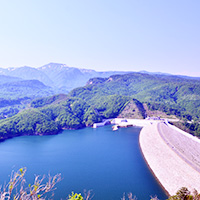
Isawa Dam (Lake Oshu)
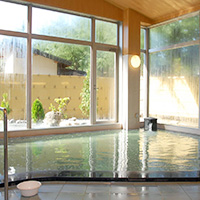
\Yakeishi KUA-PARK Himekayu
The "Yakeishi Mountain Range Route" along National Route 397 is highly recommended. See Isawa Dam, the largest rock-filled dam in Japan. The highlight is one of Japan's three most important settlements, the Isawa Plains Alluvial Fan.
In addition, Oshu is a production center for rice, apples, Maesawa Beef and Iwate / Oshu Beef. There are "Harvest Festival" events and direct sales at various places throughout autumn, where you can purchase fresh autumn tastes of new rice and brand-name apples.
Estimated time required: 7 hours 15 minutes
 Mizusawa Interchange (IC)
Mizusawa Interchange (IC) Miwakemori Park Observation Tower
Miwakemori Park Observation Tower- From the only hill in the Isawa Plains Alluvial Fan, you can take in the Yakeishi Mountain Range, scattered houses and settlements, as well as rice fields. The park also features an athletic course, nature paths and camp grounds.
 Oshu-Isawa Hot Springs MIZUKI
Oshu-Isawa Hot Springs MIZUKI- These hot springs feature almost 100% alkaline source, leaving the body warm and the skin smooth. It is most suitable as a stopover if you are looking for a nice relaxing hot spring, rest, collecting edible wild plants or mountain climbing at Kurikoma Seminational Park or Mt. Yakeishi.
 Isawa Dam (Lake Oshu)
Isawa Dam (Lake Oshu)- Isawa Dam is Japan's largest rock-fill dam, with a height of 132m, a crest length of 723m, a dam volume of around 1,350m3 and a total reservoir capacity of 143 million m3. You can get a great view of the magnificent scale of the dam and of Lake Oshu from the Lake Oshu Observation Tower. (Closed during winter; Large-sized buses not allowed.)
 Yakeishi KUA-PARK Himekayu
Yakeishi KUA-PARK Himekayu- Beginning with the “BIHADA-NO-YU” (Waters of Skin Beauty) where you can bask in the hot spring while taking in the scenery of the Yakeishi Mountains, there are Eight types of baths in which you can enjoy outdoor hot springs and even wear a swim suit in some. The warm water pool is especially popular with everyone, young and old. You will also find an herb garden and bungalows on the grounds so that you can enjoy the outdoor life.
 Mizusawa Sightseeing and Products Center, Z-Plaza Aterui
Mizusawa Sightseeing and Products Center, Z-Plaza Aterui- The center offers sightseeing information for all of Iwate Prefecture, with an emphasis on Oshu, as well as sells various special products and fresh agricultural products. There is a cafe and a snack booth as well. It is fully equipped with a large parking lot and public restrooms.
 Esashi-Fujiwara Heritage Park
Esashi-Fujiwara Heritage Park- This magnificent theme park recreates the splendor of Heian period architecture that prospered during the four generations of the Fujiwara clan. The park has been used as locations for filming TV and movies, and sometimes filming is open to the public. You can enjoy learning the legends and folktales of Esashi, as well as its history, by donning the armor of warriors, trying your hand at archery and putting on kimono of the period.
 Mizusawa Interchange (IC)
Mizusawa Interchange (IC)


 Mizusawa Interchange (IC)
Mizusawa Interchange (IC) Esashi-Fujiwara Heritage Park
Esashi-Fujiwara Heritage Park Kura-machi Mall
Kura-machi Mall Oshu Traditional Industry Hall
Oshu Traditional Industry Hall Chuson-ji Temple
Chuson-ji Temple Motsu-ji Temple
Motsu-ji Temple Hiraizumi-Maesawa Interchange (IC)
Hiraizumi-Maesawa Interchange (IC)

 Mizusawa Interchange (IC)
Mizusawa Interchange (IC) Esashi-Fujiwara Heritage Park
Esashi-Fujiwara Heritage Park Esashi Native District Cultural Museum
Esashi Native District Cultural Museum Oshu Space and Astronomy Museum
Oshu Space and Astronomy Museum Oshu Samurai Family House Museum
Oshu Samurai Family House Museum Yakeishi KUA-PARK Himekayu
Yakeishi KUA-PARK Himekayu Isawa Marugoto Information Center
Isawa Marugoto Information Center Cattle Museum
Cattle Museum Chuson-ji Temple
Chuson-ji Temple Motsu-ji Temple
Motsu-ji Temple Hiraizumi-Maesawa Interchange (IC)
Hiraizumi-Maesawa Interchange (IC)

 Hiraizumi-Maesawa Interchange (IC)
Hiraizumi-Maesawa Interchange (IC) Chuson-ji Temple
Chuson-ji Temple Goto Shinpei Memorial Hall
Goto Shinpei Memorial Hall Oshu Samurai Family House Museum
Oshu Samurai Family House Museum Saito Makoto Memorial Hall
Saito Makoto Memorial Hall Takano Choei Memorial Hall
Takano Choei Memorial Hall Mizusawa Sightseeing and Products Center, Z-Plaza Aterui
Mizusawa Sightseeing and Products Center, Z-Plaza Aterui Mizusawa Interchange (IC)
Mizusawa Interchange (IC)

 Mizusawa Interchange (IC)
Mizusawa Interchange (IC) Shobo-ji Temple
Shobo-ji Temple Kokuseki-ji Temple
Kokuseki-ji Temple Motsu-ji Temple
Motsu-ji Temple Chuson-ji Temple
Chuson-ji Temple Hiraizumi-Maesawa Interchange (IC)
Hiraizumi-Maesawa Interchange (IC)

 Mizusawa Interchange (IC)
Mizusawa Interchange (IC) Miwakemori Park Observation Tower
Miwakemori Park Observation Tower Oshu-Isawa Hot Springs MIZUKI
Oshu-Isawa Hot Springs MIZUKI Isawa Dam (Lake Oshu)
Isawa Dam (Lake Oshu) Yakeishi KUA-PARK Himekayu
Yakeishi KUA-PARK Himekayu Mizusawa Sightseeing and Products Center, Z-Plaza Aterui
Mizusawa Sightseeing and Products Center, Z-Plaza Aterui Esashi-Fujiwara Heritage Park
Esashi-Fujiwara Heritage Park Mizusawa Interchange (IC)
Mizusawa Interchange (IC)